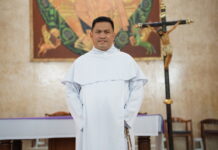COMMERCE junior “Ranny” heard a strange sound behind him as he was striding alone on the España walkway past 10 in the evening.
Ranny looked back but there was no one around. Frightened, he dashed to the gate near the Engineering Bldg., reciting the Hail Mary.
“It wasn’t a prank joke,” Ranny told the Varsitarian. “The horror felt like someone was standing behind me, but I just couldn’t see it.”
Ranny’s confession is just another Thomasian urban legend. Blame it on the University’s centuries-old past, which breeds the ghost stories, said Jose Victor Torres, a History professor from the Faculty of Arts and Letters.
Torres explained that thousands of people have died within the walls of the University—some committed suicide, a handful expired on deathbeds, while many others have been buried here even before the University occupied the grounds in 1927.
A popular website, shadowlands.net, even claims that there are ghosts and wailing voices that can be heard from the 2nd and 3rd floors of the UST Main Bldg.
“The University’s buildings have so many secrets to tell,” Torres said. “It has witnessed so many histories, causing people to make and think of their own tales. Some may be real, others may be not.”
Sleepy hallow
Torres himself said he was a witness to an apparition of a dead priest walking along the Benavides Park at midnight.
He and two friends greeted a man wearing the Dominican habit as they were walking on the Benavides Park one midnight in 1987. The priest even nodded back. But when they turned around seconds later, the priest was nowhere in sight.
“At first, we did not mind the priest because we just came out from the Arts and Letters Bldg.—we’re too tired,” Torres said. “But it startled us after the priest nodded because we realized there was something suspicious about him walking alone at midnight.”
In the feature article “Who You Gonna Call” published in the Sunday Inquirer Magazine last Oct. 29, Fr. Jose Francisco Syquia, director of the Archdiocese of Manila’s Office of Exorcism and a UST AB Philosophy alumnus, said hauntings are triggered by souls in purgatory seeking prayers. It could also be due to diabolical infestation, which means evil spirits are frequently visiting a place. But whatever the case, Syquia said that people should look at the history of the place and when the paranormal occurrences began.
Although ghosts are often believed to appear at nights, there are also ghosts that appear even on sunny school days.
Take the scary encounter of “Carl,” a Faculty of Medicine and Surgery student, while attending his Anatomy Class. His classmates were dissecting a corpse when he went to the Ossarium, a storage room for human bones. As he peeked through its glass door, he saw a figure inside the Technician’s room.
Thinking that the figure was one of the school’s technicians he needed to consult, he called their names. To his dismay, nobody heeded his calls. There was no one in the room.
Another specter incident occurred in the barracks near the Hospital morgue. Janitor “Nonoy” just woke up from his night duty. After doing his morning exercise, he went to the comfort room to wash his face, when suddenly the lights went on and off.
Thinking it was the guard “Mang Ambo” who is known for pulling pranks, he quickly opened the door of a cubicle, hoping to catch him off-guard. To his surprise, he was alone in the comfort room.
Then, as he went back to his routine, the phone rang. Mang Ambo just died of a freak accident.
In the College of Nursing, Prof. “Lea” was teaching Pharmacology to a class of 50. As she carried on with her lecture, she saw a female student sitting on the corner of the farthest row. Lea said there was something strange about that student who remained silent during the class and was not moving on her seat. Thinking she would like to be alone, Ms. Lea continued to discuss.
After a few minutes, she looked back again, and the lone student was nowhere.
Torres explained that the Filipino culture of believing in ghosts and spirits were key factors to why these stories gain following.
“It is in our culture to play with ghost stories, and even create ghostly figures,” Torres said.
But Torres said that before believing these stories, one should first experience them.
“Believing ghost stories too much creates misunderstandings and false rumors,” he said. “Some people create the stories they fear. And some invent ghost stories just to entertain others.”
Although Torres was a witness to some of these “ghostly” occurrences, he debunked the idea that the 21.5-hectare UST was once a hallowed ground. He said that the University was an open field for growing trees, rice crops, and grasses.
“People used to think that way because the place is too old,” he said. “The University was once a rice field, that’s it. The archives have concrete evidence that UST was not a cemetery, but an open field, with a swamp.”
Locked in war
Belief in UST’s “grim” history also seems to root from the fact that UST once served as an internment camp for 3,789 foreign civilians during the Japanese occupation.
Records show that there were 2,794 Americans, 734 British, 100 Australians, and a handful of Norwegians, French, Egyptians, and Nicaraguans imprisoned inside the campus walls.
According to accounts, some of them died of diseases caused by famine. Some even committed suicide, while others were executed by the Japanese invaders.
“Most of the recorded people who died were old men imprisoned. They were the ones who no longer had enough strength to recover,” Torres said.
Torres also stressed that Japanese invaders executed some of the internees, but not inside the University.
“Classmates and friends tell me about these ghosts—some of them headless and shackled—who roam along the Main Bldg. halls at night,” Accountancy junior Denise Morales said. “Although we have not actually seen them, we are too scared so we try to keep away from that building at night.”
“There are only four people executed from the camp, but the Japanese did not kill them here,” Torres said. “They were brought into the North Cemetery where they were killed and buried.”
Crying ladies
While other ghost legends were loosely based on rumors and legends, some tales developed from stories of students who committed suicide and who are supposedly haunting the University.
Take the story of a young female student who hanged herself inside a cubicle in one of the first-floor restrooms of the Main Bldg. Students who have used the toilet said they felt something knocking their foreheads inside the cubicle.
“The story I knew frightens me and makes me think someone will tap my forehead when I’m in the cubicle,” said College of Science student Katrina Francia. “Sometimes, I do think something tapping at it.”
In 1987, another suicide occurred on the fourth floor of the St. Raymund’s Bldg. A Commerce student jumped off the building due to psychological problems. She was broken hearted as her parents were considering separation.
Torres confirmed this story having witnessed it during his college days in the University.
Seconds after she jumped, Torres said the girl’s body was found dead with her bones broken into pieces and blood spilling on the building’s floor.
“Since then, rumors say that they hear her crying at night in Room 406,” he said.
Security guards have also heard this lady’s voice during their night duties.
“Mang Robert” narrates the night when he felt his skin crawl. That’s the time when he heard a voice coming from a room at the fourth floor, crying.
“May umiiyak doon, batang babae,” he said. “Hinahanap ko siya kasi baka naiwanan siya palabas o baka naikandado ‘yung pinto.”
But there was nobody on the floor except him.
Another ghost story that circulates around the campus was that of a singing lady at the fifth floor of the Music Bldg.
Arts and Letters student Sheena Badulis said that one night, after watching theatre performances at the Albertus Magnus auditorium, she and her classmates heard a voice humming with them. Frightened, all of them ran as fast as they could.
“It was the typical scary voice you hear in horror movies,” Badulis said. “That’s why we panicked and ran quickly.”
After the creepy incident, Badulis said one of her friends told her that there was also a mysterious lady heard singing at the 5th floor of the Education Bldg.
“No one knows where the singing lady comes from,” Badulis said. “That’s why a lot of people are still in doubt if these stories are true or not.”
Beyond doubt, the University houses historical structures as it witnessed sundries of life for almost 400 years. Some of thehistorical accounts are definitely scarier than others. But should they be taken as gospel or taken with a grain of salt?
“At this time, you will never know who tells the truth and who makes stories,” Torres said. “Not until you become a witness yourself.” With reports from Raychel Ria C. Agramon












